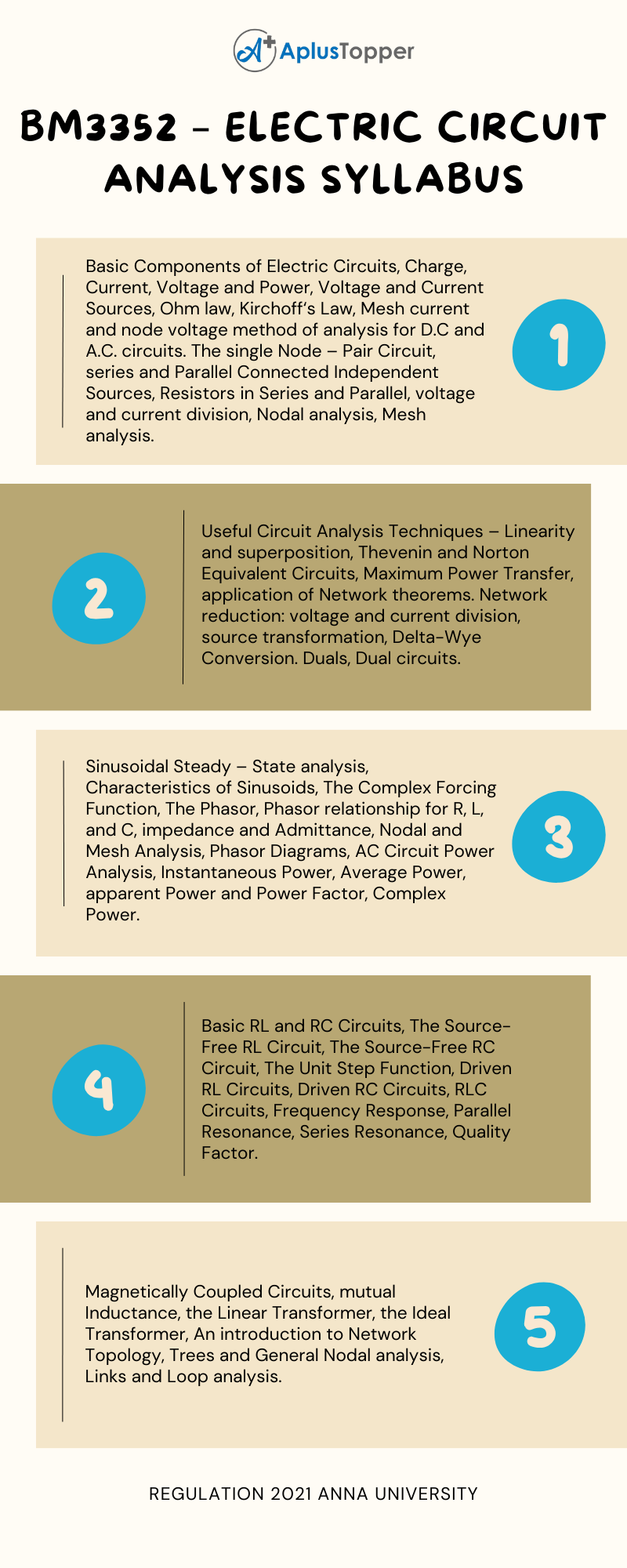Electric Circuit Analysis syllabus regulation 2021 of Anna University B.E Medical Electronics. In this article, we would like to provide the semester III of the B.E Medical Electronics Engineering Syllabus.
We would like to discuss the detailed syllabus of the Subject code BM3352 – Electric Circuit Analysis. You can easily note down and take notes according to the syllabus. We add a unit-wise syllabus to this page. Along with that, we included the required textbooks and references from the expert faculty. You can also prepare for exams with a clear picture of the syllabus. The following unit-wise syllabus will assist you well. I hope this information is useful. Never forget to share it with your friends.
If you want to know more about the B.E Medical Electronics Engineering syllabus connected to an affiliated institution’s four-year undergraduate degree program. We provide you with a detailed Year-wise, semester-wise, and Subject-wise syllabus in the following link B.E Medical Electronics Engineering Syllabus Regulation 2021 Anna University.
Aim Of Objectives:
- To introduce the basic concepts of DC and AC circuits behavior.
- To study the transient and steady-state response of the circuits subjected to step and sinusoidal excitations.
- To introduce different methods of circuit analysis using Network theorems, duality and topology.
BM3352 – Electric Circuit Analysis Syllabus
Unit – I: Basic Circuits Analysis
Basic Components of Electric Circuits, Charge, Current, Voltage and Power, Voltage and Current Sources, Ohm law, Kirchoff‘s Law, Mesh current and node voltage method of analysis for D.C and A.C. circuits. The single Node – Pair Circuit, series and Parallel Connected Independent Sources, Resistors in Series and Parallel, voltage and current division, Nodal analysis, Mesh analysis.
Unit – II: Network Theorem And Duality
Useful Circuit Analysis Techniques – Linearity and superposition, Thevenin and Norton Equivalent Circuits, Maximum Power Transfer, application of Network theorems. Network reduction: voltage and current division, source transformation, Delta-Wye Conversion. Duals, Dual circuits.
Unit – III: Sinusoidal Steady State Analysis
Sinusoidal Steady – State analysis, Characteristics of Sinusoids, The Complex Forcing Function, The Phasor, Phasor relationship for R, L, and C, impedance and Admittance, Nodal and Mesh Analysis, Phasor Diagrams, AC Circuit Power Analysis, Instantaneous Power, Average Power, apparent Power and Power Factor, Complex Power.

Unit – IV: Transients And Resonance In Rlc Circuits
Basic RL and RC Circuits, The Source- Free RL Circuit, The Source-Free RC Circuit, The Unit Step Function, Driven RL Circuits, Driven RC Circuits, RLC Circuits, Frequency Response, Parallel Resonance, Series Resonance, Quality Factor.
Unit – V: Coupled Circuits And Topology
Magnetically Coupled Circuits, mutual Inductance, the Linear Transformer, the Ideal Transformer, An introduction to Network Topology, Trees and General Nodal analysis, Links and Loop analysis.
Text Books:
- Hayt Jack Kemmerly, Steven Durbin, “Engineering Circuit Analysis”, Mc Graw Hill education, 9th Edition, 2018.
- Joseph Edminister and Mahmood Nahvi, “Electric Circuits”, Schaum’s Outline Series, Tata McGraw Hill Publishing Company, New Delhi, Fifth Edition Reprint 2016.
References:
- Robert.L. Boylestead, “Introductory Circuit Analysis”, Pearson Education India, 12th Edition, 2014.
- John O Malley, Schaum’s Outlines “Basic Circuit Analysis”, The Mc Graw Hill companies, 2nd Edition, 2011.
- Charles.K.Alexander, Mathew N.O.Sadiku,” Fundamentals of Electric Circuits”, McGraw Hill, 5th Edition, 2012.
- Allan H. Robbins, Wilhelm C. Miller, “Circuit Analysis Theory and Practice”, Cengage Learning, Fifth Edition, 1st Indian Reprint 2013.
Related Posts On Semester – III:
- MA3351 Transforms and Partial Differential Equations
- EC3354 Signals and Systems
- CS3391 Object-Oriented Programming
Also Check:
